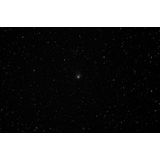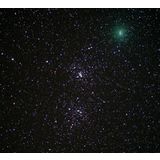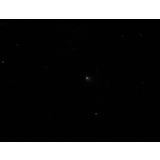
The year 2013 looks to be a very promising time to observe comets. Because two of these events - the appearance of Comet C/2011 L4 PANSTARRS and Comet C/2012 S1 ISON - may be very spectacular, viewers may wish to take more careful notes of what they view and when.
Why bother? Although you may not be interested in observing programs such as those offered by the Astronomical League, there may be a time in the future when your observations will become important to you. Comet challenges take several years to complete and the ones you observe now might be the start of a great journey of learning and logging. Why not start out right?
While a comet is very dim and distant, such as C/2012 S1 ISON at the beginning of 2013, it will require the use of CCD equipment to both reveal and verify position. While many amateur observers do not take astrophotos, those who do are encouraged to image even faint comets as often as possible. These "comet snapshots" should be carefully labeled, giving the comet's position and known magnitude. These will act as a photographic record of your early observations. Some comets, such as C/2011 L4 PANSTARRS may be bright enough during their pass through our astronomical neighborhood to be captured with average DSLR cameras or inexpensive solar system imaging cameras.
As a comet nears the Sun, it begins to sublimate and become brighter - making it accessible to average telescopes and visual observations. For those who do not use CCD equipment, comets provide an ideal opportunity to begin logging your observations using simple sketches and labeling methods. Once your comet target has been located and verified, logging your observations becomes a fairly easy process. There may even be a time when you can observe a given comet with just binoculars or your unaided eye, depending on its magnitude. Who knows? In the case of Comet C/2012 ISON, which is expected to become very bright, you may even be able to observe it during daylight hours! All of these observations "count". Begin by logging the basics of your comet observation. Write down specifics such as the date, universal time, latitude and longitude of your physical position, equipment in use, magnification and sky conditions. Now draw a circle which will represent your eyepiece field of view. Once you have located the comet, start your sketch by drawing the brightest stars you can see in the eyepiece. When at all possible, label one or more of these stars with their proper designation. You can find this information on a good star chart or planetarium program. If there are no primary stars visible in the area, draw an arrow on your chart which points in the direction of a major star and label it. If you are using binoculars or just your eyes, the field will be much larger, but the principle is the same.
When your star field sketch is complete, it's time to add the comet. Be sure to make it proportionate in size to the stellar background. For example, if you are drawing a circle to represent the comet's coma, make sure the circle covers as close to the same approximate area as what you see. If the comet has a concentrated nucleus, do your best to represent this in your drawing. Does the comet have a tail? If so, be sure to add this into your comet portrait as well. Once these elements are in place, label the edges of your sketch with the cardinal directions. West will always be the direction the star field "drifts" out of the telescope or binocular's field of view. After your initial sketch, be sure to place an arrow on subsequent drawings showing which direction the comet is headed. Add any additional information you may have to your sketch as well... such as the official Right Ascension / Declination (R.A. and Dec) coordinates and estimated magnitude. This type of information is available through the Harvard Minor Planet Center.
While this might seem like a lot of extra work just to keep track of a comet, there may very well be a day when you'll appreciate the extra time you took to log your comet observations properly. Even if you never choose to use them in a structured observing program, you'll enjoy looking back at the nights you spent at the eyepiece and how you watched a comet change over a period of time. Who knows? You may very well catch the beginning of an exciting event, such as a comet break-up or a sudden flare in brightness! It's all part of good observing and you can do it!





















